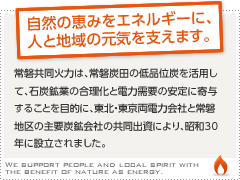Glossary of IGCC
| Term | Meaning |
|---|---|
| Amine | A chemical solution used in a gas cleanup process to remove sulfur compounds from coal gas through absorption. |
| Subbituminous coal | While less commonly used as a fuel for coal-fired power generation in Japan, it can provide cost advantages over bituminous coal. With abundant reserves, its use for IGCC is currently being studied. It has lower carbon content and lower calorific values than bituminous coal. |
| Sulfur recovery system | A system used to collect sulfur in the form of gypsum by absorption using limestone slurry following the conversion of sulfur content into sulfur oxides in the off-gas incinerator. |
| Sulfur compound | A compound containing hydrogen sulfide (H2S), carbonyl sulfide (COS), and so forth generated by the gasification of coal. |
| Gasifier | A reacting furnace used to convert pulverized coal into syngas. |
| Gas turbine fuel switching | Switching fuels for the gas turbine between kerosene and coal gas. When starting up the plant, we must use kerosene as fuel for the gas turbine until coal gas is generated in the gasifier. Upon shutdown of operations, kerosene is once again used in place of coal gas. |
| (Char recycling unit) Cyclone separator |
A unit used to collect unburned and fine-particle char from coal gas using centrifugal force. |
| Auxiliary power | Power needed to operate plant equipment such as pumps and fans. |
| Slag | A glassy solid in granular form discharged when the ash in coal is melted inside the high-temperature gasifier and rapidly cooled when dropped into water at the bottom of the gasifier. |
| Coal gasification reaction | A series of reactions in which, after coal breaks down into volatile matter (gases) and char (solid content) when heated, char turns itself into such gases as carbon monoxide (CO) and hydrogen (H2) by reacting with carbon dioxide (CO2), water (H2O) and other substances. |
| Net thermal efficiency | An index used to indicate thermal efficiency obtained by subtracting the power needed to operate a plant from the power generated by the plant. Efficiency here represents how much of the coal energy supplied to a plant becomes electric power. |
| De−NOx unit | A unit used to break down nitrogen oxide into nitrogen (N2) and water (H2O) using ammonium and catalyst to remove nitrogen oxide from flue gas discharged by the gas turbine. |
| Nitrogen compound | A compound that contains nitrogen, e.g., ammonium (NH3), resulting from the combustion of nitrogen content of coal and combustion air. |
| Char | An unburned particles obtained though the removal of volatile content and water from coal in a gasifier composed primarily of ash content and fixed carbon. |
| Dual mode | A mode of operation that permits the use of two types of fuel. While coal gas is normally used as fuel for gas turbines, kerosene (for instance) is used when starting/stopping a plant. |
| Halogen | A family of elements including fluorine (F) and chlorine (Cl). In the case of the demonstration plant under discussion, it refers to any of the elements present in coal gas in the form of hydrogen fluoride (HF), hydrogen chloride (HCl), and so forth. |
| Fly ash | Ash content of coal in powder form. It is generated by combustion inside the boiler used in conventional coal-fired power generation with pulverized coal. |
| (Char recycling unit) Porous filter |
A device used to collect microscopic particles of char from coal gas with a filter. It is located downstream from the cyclone separator. |
| Bituminous coal | A type of coal commonly used as fuel for coal-fired power generation in Japan. It offers the second highest carbon content after anthracite coal and higher calorific values than subbituminous coal. |
| ASU | A unit used to separate nitrogen (N2) and oxygen (O2) in air drawn in from atmosphere. An abbreviation for Air Separation Unit, it is an important part of an IGCC process, which uses nitrogen for the safe transport of pulverized coal and for other functions. |
| LHV | An index used to refer to the energy generated by fuel combustion. An abbreviation for Lower Heating Value, it excludes evaporative latent heat (condensation heat) from the steam generated by combustion and the water content of the fuel. The index including evaporative latent heat (condensation heat) of steam is known as HHV (Higher Heating Value). |
| SGC heat exchanger | A unit used to generate steam for steam turbine operations. Also known as a syngas cooler, it makes use of the heat in coal gas produced in a gasifier. |
